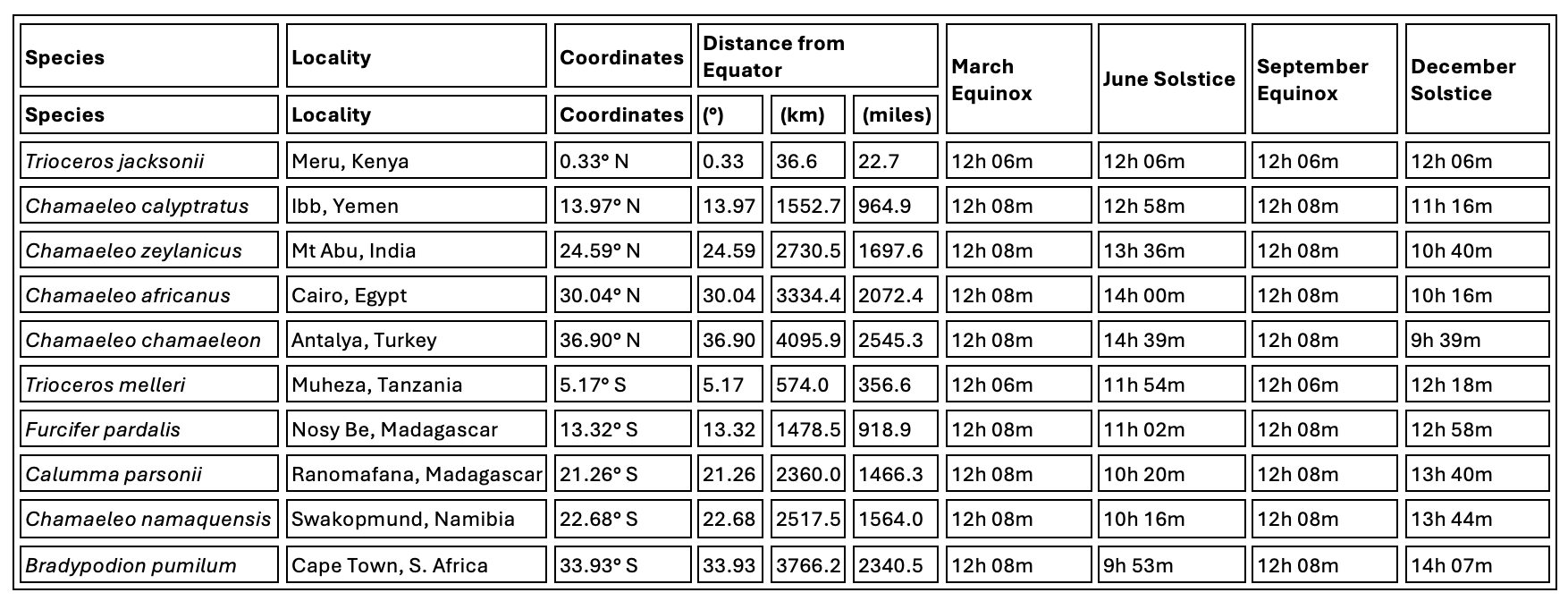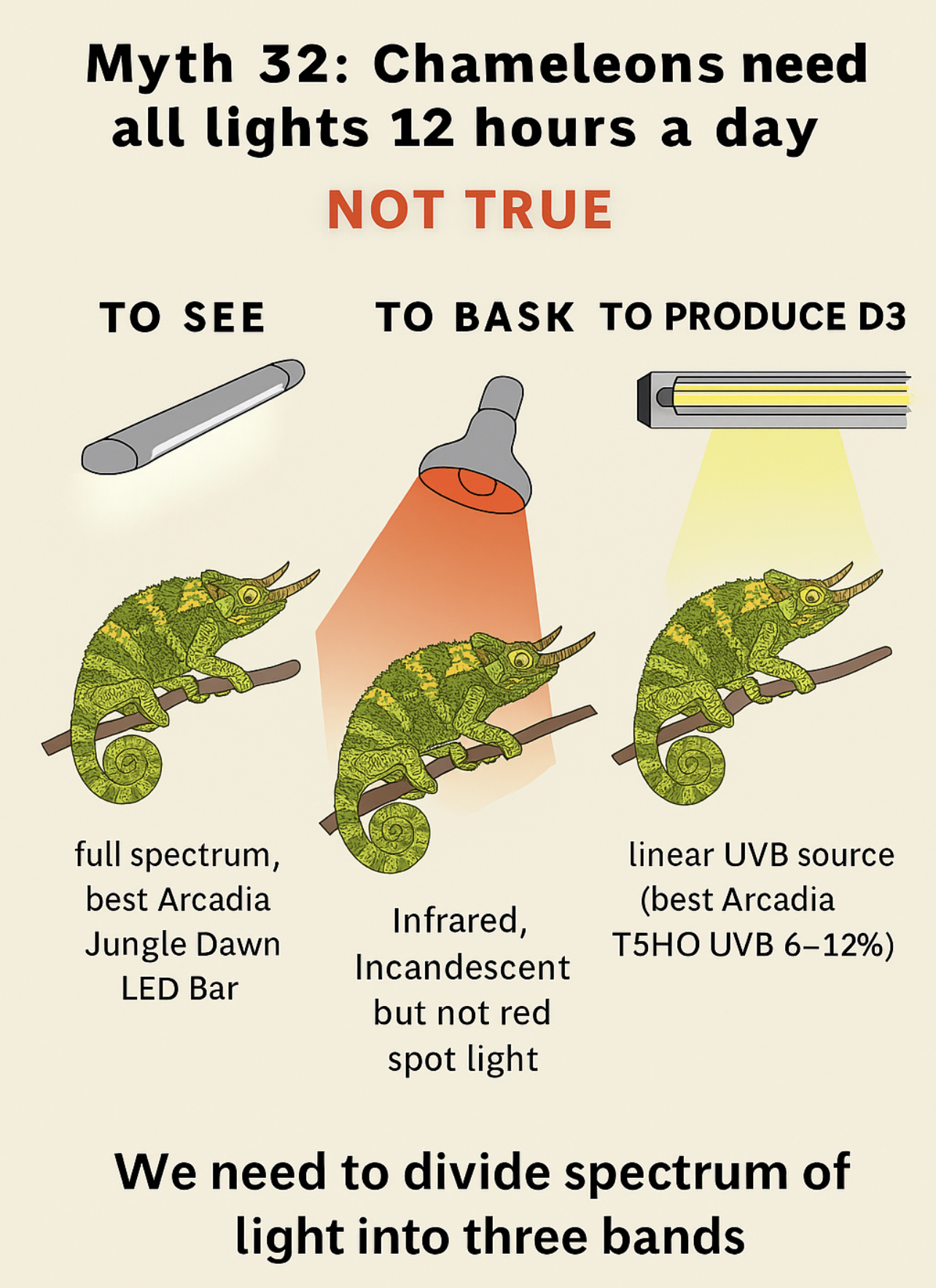Myth 32: "Chameleons Need All Lights 12 Hours a Day"
Not true. And dangerously misleading.
Learning from Nature: The Sun Is the Only True Light Source
In the wild, chameleons evolved under the sun—a dynamic, full-spectrum source of light that changes in intensity and spectral composition throughout the day and year. In captivity, we cannot replicate this complexity with a single artificial light. Technically and biologically, it's impossible. So, we must divide the sun's spectrum into three essential lighting components, each serving a distinct purpose:

1. TO SEE: Full-Spectrum White Light
Purpose: Enables vision, feeding, movement, and comfort.
Best Option: Arcadia Jungle Dawn LED Bar
Why It Matters: Without it, chameleons become disoriented, inactive, and stressed.
2. TO BASK: Infrared (IR) Light
- Purpose: Provides warmth for digestion and activity.
Best Option: Gentle incandescent spotlight (not red!)
Why It Matters: Red bulbs distort heat perception, biases vision. Overheating leads to sterility, exhaustion, or death.
3. TO PRODUCE D3: UVB Light
Purpose: Stimulates vitamin D3 synthesis for calcium metabolism.
Best Option: Arcadia T5HO UVB 6–12%
Why It Matters: Without UVB, chameleons suffer from metabolic bone disease and other deficiencies.
The Golden Rule: It's All About DOSAGE
Every life-sustaining factor—light, heat, humidity, nutrition—follows the same principle:
Too little → deficiency, dysfunction, slow death
Too much → stress, damage, quick death
Just right → thriving, vibrant health
Natural Light Cycles: What Happens in the Wild?
White Light
Present all day, shifting in tone and intensity
Morning/evening: warmer, orange spectrum
Daytime: bright but filtered by clouds, mist, dust
Infrared Light
Follows white light's rhythm
Peaks during sunlit hours
Fades with dusk
UVB Light

Strongest during midday basking
Diffused exposure even in shade (UVI 0.5–1)
Chameleons regulate exposure by moving in/out of sun
Important: Chameleons do not sit in direct sunlight all day. They self-regulate to avoid overheating and UV damage.
How Long Is a Day?
Contrary to myth, a day is not always 12 hours long. Even near the equator, daylight duration fluctuates with Earth's rotation and seasonal shifts. The further from the equator, the greater the variation between summer and winter day lengths.

Chameleon Daily Rhythm
Night: Sleep in cool, humid, foggy conditions
Early Morning: Minimal movement, cold and inactive
Post-Sunrise: Brief basking to warm up and activate digestion
Daytime: Active in shade, hunting, interacting, resting
Afternoon: Occasional short basking if temps drop
Evening/Night: Sleep, fog-drinking, relaxation
Simulating Nature: Why It's Essential
Chameleons evolved under specific environmental cycles. These cycles influence:
Hormonal balance
Sexual activity
Growth and development
Appetite and behavior
Seasonal rhythms (e.g., mating, hatching)
We cannot override millions of years of evolution in a few captive generations.
Simulating Yearly and Daily Cycles
Yearly Cycles
Adjust light duration seasonally based on species origin
Failure to do so leads to exhaustion, hormonal imbalance, and early death
Daily Cycles
White Light: On all day; ideally with variable intensity
Infrared Light: 30 minutes in morning + 30 minutes in late afternoon• Never mist during IR exposure (risk of respiratory infection)
UVB Light: 4–6 hours during active basking periods• Proper lamp distance (2–12 ft) is critical
Avoid overexposure (can cause burns, blindness, sterility)
Hemisphere Confusion & Natural Light Interference
Most keepers live in hemispheres opposite to their chameleons' native range. This causes reversed seasonal light cycles. If natural daylight enters the enclosure:

Chameleons may ignore artificial light and follow natural cues
Or they may ignore both and rely on their internal clock
Solution: Observe behavior and adjust lighting accordingly
Conclusion: Light Is Not Just Illumination—It's Biology
Chameleons don't need "12 hours of light." They need the right light, in the right spectrum, for the right duration, at the right intensity. Anything less—or more—is a recipe for dysfunction.
By respecting nature's blueprint and simulating its rhythms, we don't just keep chameleons alive—we help them thrive.
Let's stop chasing convenience and start honoring biology.
